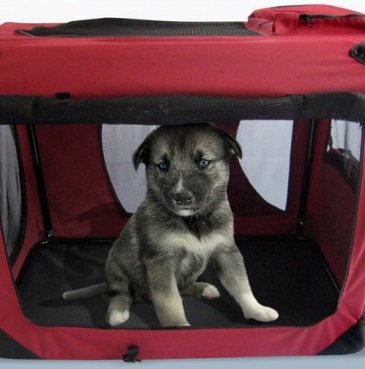
Making Post-Surgery Pet Recovery Easier and Happier
June 7, 2024
Your Words Have Power, Use Them Wisely
June 21, 2024All training starts with taking advantage of natural animal instincts to reinforce the behaviour you desire.
Crate training your puppy from a young age establish you as the Alpha member of his “pack”. Not only does it give him his own space where he’ll feel secure and comfortable, which is especially important in a household with other dogs, but offers clear and easily understandable lines of discipline and acceptable behaviour.
The primary use for a crate is housetraining, as dogs don’t like to soil their sleeping areas. Another is that dogs love predictability – to know what is going to happen in any given situation which makes them happy and secure. The crate can also limit access to the rest of the house while learning rules, like not to chew on furniture, crates are also a safe way to travel with your dog in the car.
A crate that is just the right size will be perceived as his “den”, where puppies never mess, where they can comfortably stand and turn around. To encourage your puppy to “like” his new den, you should equip it with soft bedding and start with placing a tasty treat inside for him to retrieve, while leaving the door open. Let him come and go freely for an hour or so and offer high praise each time he enters the crate, making it an overall pleasant experience.
From there, when his attention is on his treat, close the door for 10 or 20 seconds and praise him quietly, “What a good boy, it’s ok, such a good boy!”. Then let him out without praise, just a pat. Do this for increasingly longer intervals, but do not give him a chance to get upset. It is crucial that every training session ends on a happy note.
Once he sees the crate is his own private territory, he will go in there on his own, expecting treats and attention. When he does, say, “Wanna crate?” with a happy face while getting his treats. Start leaving the room while he is in there for 2 minutes, gradually increasing the time. When you return, don’t make a fuss, just walk over and open the crate.
Should your puppy cry while in the crate, do not give him attention or removed them while crying. No matter what, make sure he is being good when you open the door, he will soon learn to be quiet to get out. Do not make a fuss, just gently open the door and take him out to relieve himself. When he potties, praise him to high heaven! If your puppy has an “accident” in the crate do not discipline, just clean it up without emotion. He will soon learn his lesson. If possible, try to clean it while he is outside so he returns to a fresh crate. Ensure your puppy is exercised before being crated and don’t crate a young puppy for longer than 2 hours at a time, it is important not make a prison of his crate.
Never punish your puppy in the crate, he’ll dread going back. Crate your puppy only until you can trust him not to destroy the house. After that, it should be a place he goes to voluntarily as a comfortable and safe space.
Reasons to consider crate training for your puppy:
- It will create an environment where they feel very safe and secure.
- Puppies may experience some measure of separation anxiety when left alone. This leads to undesirable or destructive behaviour including chewing, digging, or even voiding their bowels. When placed in a crate, he will feel safe because nothing can harm him. He will sleep and chew and wait for you to return.
- Crate training can be very beneficial when leaving him overnight at the vet. With crate training, he is sure you will return, as you always do. Otherwise your dog will cry the entire time, feeling lost and abandoned. The vet’s office is strange and will cause anxiety, but nothing like the pure terror he will feel without any experience of being confined.




